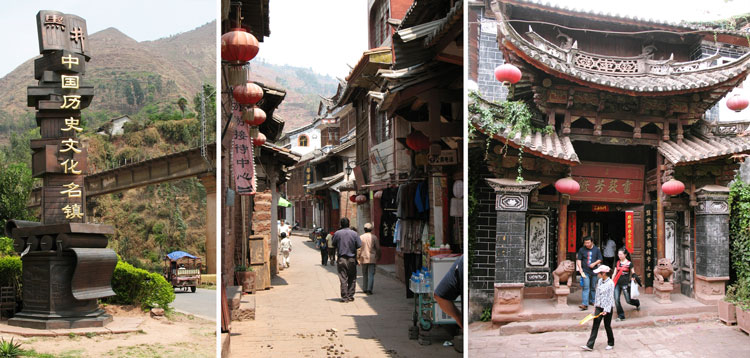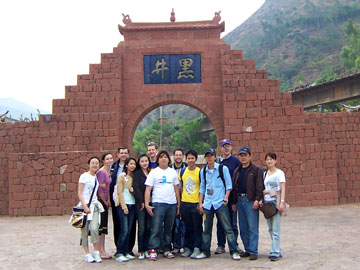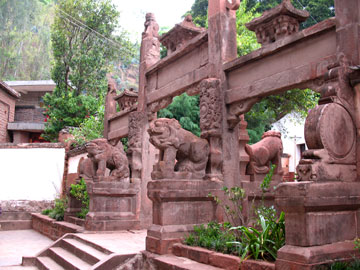|

|
Dali and Lijiang are beautiful, but their
popularity has also turned them into "tourist traps." If you want to see
an ancient Chinese city that still looks like a real place (not a
"preserved" place where you can see lots of tourists and souvenirs), then
perhaps you should visit Heijing in Yunnan Province. In April 2007, I got
to go with fellow foreign students from Kun Shi Zhuan.

Heijing
(meaning "black well," though short for "black cow salt well") dates back
to 200 BC, when a man's black cow wandered off and ended up at a salt
well. The town was recognized in 2005 as an historic and cultural treasure
worth preserving (one of 34 towns nationwide, and the only one in Yunnan).
Unlike Dali and Li Jiang, you won't find fancy hotels, or tourist goods in
every shop. People still live here, and most of the shops operate to serve
the local people, just as they have done for centuries. (Above center:
narrow streets lined with ornate roofs and woodwork add to the village's
charm, but watch your step! There are lots of horses about.) (Above right:
The family who got rich from the area's salt built this mansion
generations ago. Today you can stay here, bed-and-breakfast style. It is
one of the town's main attractions, and a tour guide will tell you all
about it's history--if you speak Chinese!)

Heijing is
nestled between mountains with a river (and train track) in between. This
photo was taken from the mansion's second floor, looking out from one
hillside, down on the village and over to the mountain on the other side
of the tracks. Many structures (and even the "western" bathtubs in this
courtyard) are made from local Redstone, which is still important to the
area's economy.
|
|

Salt manufacturing is the key to this village's longevity.
Its salt was particularly famous during the Ming and Qing dynasties
(around AD 1400-1900). This part of town shows how salt was made; you can
even "refine" a little to take home. |

Most of the
foreign students at Kun Shi Zhuan study with the help of private tutors
(like I do). The staff and two teachers came along on this outing.
Students come from the US, Europe, and other parts of Asia. Here, our
group poses in front of the city's main gate. |
|

From left to
right: (1) Salt souvenirs, including heavy "bricks" of salt--in the
foreground--as they would have been carried on mules throughout China long
ago. (2) The main street is still a main street, with shops selling
household goods, clothes, medicine, foodstuffs, etc. As you walk around
you will see local children playing, old men playing chess or cards, and
other aspects of "real life." In Dali's main street, all you will see is
tourist shops and bars! (3 & 4) The main source of transportation is horse
cart. There are no motorized taxis, nor are they needed. The horses are
quaint, but with horses you get lots of flies. As I swatted the pests it
occurred to me that this was one reason why people were glad to replace
horses with the "horseless carriage." |
|

This is the gate
of an old Confucian Temple (now being used as an elementary school), which
is another main stop on the city tour. The craftsmanship in this complex
was beautiful, but since it is touched by dozens of children every day,
one can only wonder how much longer it will last. |

The road to
Heijing winds through the mountains. Seeing the fields and scattered
villages reminded me that this is how most of China's population still
lives--very different from the life I enjoy in the big city of
Kunming. |
|
Signs of change are everywhere. One can only hope that whoever is in
charge of this historic treasure will have the wisdom to preserve as much
of the ancient charm as possible, while also finding ways to attract and
care for tourists. That is never an easy task. As tourists come, property
values go up, and eventually the "mom and pop" businesses that now line
main street will be forced to make way for high-rent shops that sell stuff
no one really wants or needs. So, if you want to see this ancient town
before it gets ruined by its modern fame, you had better hurry! |

Click in the boxes below to go to some of our most popular pages. If
you get lost, just click "Home."
See our
Policy
regarding the use of materials available at Krigline.com or
Krigline.com.cn
|






